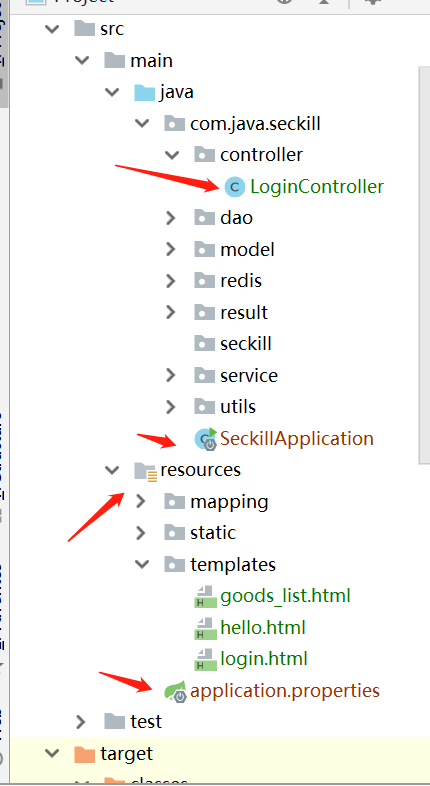最近在学习springbooot2 和 thymeleaf
程序文件

application.properties文件配置:
#thymeleaf spring.thymeleaf.prefix=classpath:/templates/ spring.thymeleaf.suffix=.html spring.thymeleaf.cache=false spring.thymeleaf.servlet.content-type=text/html spring.thymeleaf.enabled=true spring.thymeleaf.encoding=UTF-8 spring.thymeleaf.mode=HTML spring.thymeleaf.check-template-location=true # 静态文件请求匹配方式 spring.mvc.static-path-pattern=/** # 修改默认的静态寻址资源目录 spring.resources.static-locations = classpath:/templates/,classpath:/resources/,classpath:/static/,classpath:/public/ #热部署生效 spring.devtools.restart.enabled=true
在编译的时候,发现一直报这个错误:
Cannot find template location: classpath:/templates/ (please add some templates or check your Thymeleaf configuration)
之后再网上找了各种答案,发现都不能使用
-------------------------------------------------------------------------------------------------------------------
下面是正确的方案:
在pom.xml中引入如下配置
<build>
<plugins>
<plugin>
<groupId>org.springframework.boot</groupId>
<artifactId>spring-boot-maven-plugin</artifactId>
</plugin>
</plugins>
<resources>
<resource>
<!--加载资源目录-->
<directory>src/main/resources</directory>
<includes>
<!--加载配置文件-->
<include>**/*.xml</include>
<include>**/*.properties</include>
<!--加载模板文件-->
<include>**/*.html</include>
<!--加载静态文件-->
<include>/static/</include>
</includes>
</resource>
</resources>
</build>
在pom.xml中引入的文件,这样application.properties文件中可注释文件路径配置。
server.port=9099 #thymeleaf #spring.thymeleaf.prefix=classpath:/templates/ spring.thymeleaf.suffix=.html spring.thymeleaf.cache=false spring.thymeleaf.servlet.content-type=text/html spring.thymeleaf.enabled=true spring.thymeleaf.encoding=UTF-8 spring.thymeleaf.mode=HTML spring.thymeleaf.check-template-location=true # 静态文件请求匹配方式 #spring.mvc.static-path-pattern=/** # 修改默认的静态寻址资源目录 #spring.resources.static-locations = classpath:/templates/,classpath:/resources/,classpath:/static/,classpath:/public/ #热部署生效 spring.devtools.restart.enabled=true
LoginController中:
package com.java.seckill.controller;
import org.springframework.stereotype.Controller;
import org.springframework.web.bind.annotation.RequestMapping;
import org.springframework.web.bind.annotation.ResponseBody;
@Controller
@RequestMapping("/login")
public class LoginController {
@RequestMapping("/index")
public String Index() {
return "login";
}
@RequestMapping("/login")
@ResponseBody
public Boolean login(){
return true;
}
}
直接访问:http://localhost:9099/login/index